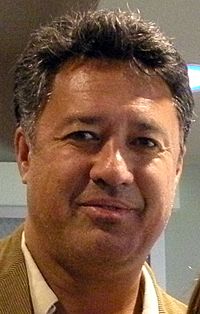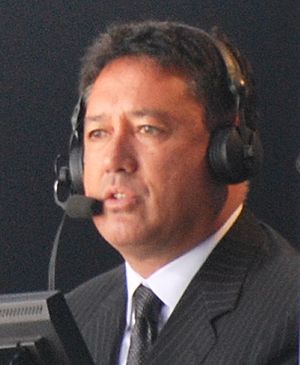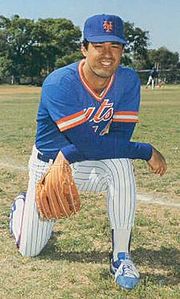Ron Darling facts for kids
Quick facts for kids Ron Darling |
|||
|---|---|---|---|

Darling in 2009
|
|||
| Pitcher | |||
| Born: August 19, 1960 Honolulu, Hawaii, U.S. |
|||
|
|||
| debut | |||
| September 6, 1983, for the New York Mets | |||
| Last appearance | |||
| August 15, 1995, for the Oakland Athletics | |||
| MLB statistics | |||
| Win–loss record | 136–116 | ||
| Earned run average | 3.87 | ||
| Strikeouts | 1,590 | ||
| Teams | |||
|
|||
| Career highlights and awards | |||
|
|||
Ronald Maurice Darling Jr. (born August 19, 1960) is a former American professional baseball pitcher who is now a popular television sports commentator. He played in Major League Baseball (MLB) from 1983 to 1995. He is best known for being a key member of the New York Mets team that won the 1986 World Series.
Since 2006, Darling has worked as a TV announcer for Mets games on SNY. He often works alongside his former teammate Keith Hernandez.
Darling was chosen for the National League All-Star team in 1985. He also won the Gold Glove Award in 1989 for being the best-fielding pitcher in the league. He is one of the best pitchers in Mets history, ranking fourth in wins with 99. In 2020, he was honored by being inducted into the New York Mets Hall of Fame.
As a pitcher, Darling was known for having five different types of pitches. He was also a great athlete who could field his position well and was sometimes used as a pinch runner. Besides the Mets, Darling also played for the Montreal Expos and the Oakland Athletics.
Contents
Early Life and College
Ron Darling was born in Honolulu, Hawaii. His mother was Hawaiian-Chinese and his father was French-Canadian. He grew up in Massachusetts and went to St. John's High School.
Darling attended Yale University, where he planned to play quarterback for the football team. However, he decided to focus on baseball instead. He started as a shortstop but later became a pitcher. He was so talented that he was allowed to play other positions on days he wasn't pitching.
On May 21, 1981, Darling pitched one of the most famous games in college baseball history. Playing for Yale, he pitched a no-hitter for 11 innings against St. John's University. In the 12th inning, St. John's finally got a hit and scored a run to win 1–0. Darling's 11-inning no-hitter is still the longest in NCAA history.
Professional Baseball Career
Minor Leagues
In the 1981 MLB draft, Darling was selected by the Texas Rangers. After playing for their minor league team, the Tulsa Drillers, he was traded to the New York Mets in 1982. He played for the Mets' top minor league team, the Tidewater Tides, before being called up to the major leagues in late 1983.
New York Mets
Journey to a Championship
In 1984, Darling earned a permanent spot in the Mets' starting rotation. Along with another young pitcher, Dwight Gooden, he helped turn the Mets into a winning team. That year, Darling had a 12–9 record.
The 1985 season was even better for Darling. He was selected for his only All-Star team and finished the season with a 16–6 record. The Mets barely missed the playoffs, but Darling proved he was a top pitcher.
Winning the World Series
The 1986 season was magical for the Mets, and Darling was a huge part of their success. He had a 15–6 record and his best-ever ERA of 2.81, which was third-best in the National League. The Mets easily made it to the postseason.
In the 1986 World Series against the Boston Red Sox, Darling pitched very well. He lost Game 1 in a close 1–0 game. But in Game 4, with the Mets needing a win, he pitched great again and helped the team win 6–2. In Game 7, Darling started but was taken out early. However, the Mets came back to win the game and the World Series championship.
Later Years with the Mets
Darling had a solid 12–8 record in 1987. In 1988, he had his best season for wins, finishing with a 17–14 record and a career-high 4 shutouts. The Mets made the playoffs but lost to the Los Angeles Dodgers.
In 1989, Darling won the Gold Glove Award as the best-fielding pitcher in the National League. He finished his Mets career with 99 wins, which is still fourth-most in the team's history.
Montreal and Oakland
In July 1991, the Mets traded Darling to the Montreal Expos. Just a few weeks later, the Expos traded him to the Oakland Athletics.
Darling had a strong season with Oakland in 1992, winning 15 games with a 3.66 ERA. He helped the A's reach the playoffs, but they lost to the Toronto Blue Jays. He continued to play for Oakland until 1995. After a tough start to the 1995 season, he was released, which marked the end of his playing career.
Career Statistics
In his 13-season career, Darling had a 136–116 win-loss record, 1,590 strikeouts, and a 3.87 ERA. He pitched 37 complete games and 13 shutouts.
Life After Baseball

Since 2000, Darling has had a successful career in television. He has worked as a broadcaster for several networks, including Fox, YES Network, and TBS.
In 2006, he became a color commentator for New York Mets games on SNY, where he works with announcer Gary Cohen and former teammate Keith Hernandez. Their broadcast team is very popular with fans. Darling has won an Emmy Award for his work as a sports analyst.
Darling is also a best-selling author. He has written three books about his experiences in baseball. In 2019, he published his third book, 108 Stitches.
In April 2019, Darling took a short break from broadcasting for health reasons but returned to the booth later in the season. On July 31, 2021, he was officially inducted into the New York Mets Hall of Fame.
Personal Life
Ron was first married to model Antoinette O'Reilly, and they have two children, Tyler and Jordan.
In 2004, Darling married makeup artist Joanna Last. They have a son, Ronald Maurice Darling III, who was born in 2016.
On May 6, 2019, Darling announced that he had been diagnosed with thyroid cancer. He has since received treatment and continues his work as a broadcaster.
See also
- List of Washington Nationals broadcasters



